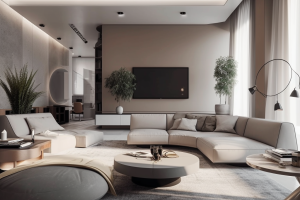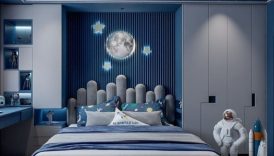Incorporating Technology into Your Modern Interior Design

Iotas: The Impact of Technology on Modern Interior Design
Smart Home Automation
The integration of smart home automation into interior design has revolutionized how we experience living spaces. Imagine walking into your home, and with a simple voice command or a tap on your smartphone, the ambiance adjusts to your liking. Smart home systems, such as lights, thermostats, and security features, not only increase convenience but also support a modern aesthetic that caters to individual lifestyles. Key features of smart home automation include:
- Incorporating Technology into Your Modern Interior Design
- Iotas: The Impact of Technology on Modern Interior Design
- Smart Home Automation
- Virtual Reality in Design
- IIotas: Enhancing Aesthetics with Tech Tools
- LED Lighting Solutions
- Digital Art Display
- IIIotas: Sustainable Technology in Interior Design
- Energy-Efficient Appliances
- Sustainable Materials
- IVotas: Interactive Tech Features in Interior Design
- Smart Furniture Integration
- Interactive Touchscreen Surfaces
- Votas: Advantages of 3D Printing in Modern Interior Design
- Customization and Uniqueness
- Efficiency and Sustainability
- Adaptive Lighting: Lights that automatically dim or brighten based on the time of day or occupancy, creating a cozy atmosphere.
- Smart Thermostats: These learn your preferences and adjust the temperature accordingly, ensuring comfort while saving energy.
- Integrated Security Systems: Smart locks and cameras provide peace of mind, allowing homeowners to monitor their spaces from anywhere.
By leveraging these technologies, designers can create spaces that are not only beautiful but also functional and efficient. For instance, a recent project involved equipping a modern apartment with an integrated lighting system that changed colors for different moods. Guests were always impressed by how easily the atmosphere shifted from a relaxing evening to an energetic gathering.
Virtual Reality in Design
Another remarkable impact of technology on interior design is the application of virtual reality (VR). This cutting-edge technology allows designers and clients to envision spaces before they are even built. With VR headsets, users can take a virtual tour through a design, exploring different arrangements and aesthetics in a fully immersive environment. Benefits of utilizing virtual reality in interior design include:
- Realistic Simulations: Clients can visualize the end product accurately, reducing misunderstandings about design choices.
- Creative Freedom: Designers can experiment with various styles and layouts in a risk-free, virtual context, making adjustments on-the-fly.
- Enhanced Collaboration: Teams can work together in real-time, regardless of their physical location, fostering creativity and innovation.
A personal experience illustrates this well: during the design of my friend’s home office, they utilized VR to rearrange the furniture and choose materials without physically moving anything. The ability to visualize different setups helped them make informed decisions, ultimately enhancing the final design. In conclusion, the integration of smart home automation and virtual reality in modern interior design represents a pivotal shift. Designers are now capable of crafting spaces that not only meet aesthetic demands but also cater to the functional needs of contemporary living.
IIotas: Enhancing Aesthetics with Tech Tools
LED Lighting Solutions
As the journey through modern interior design continues, one cannot overlook the transformative power of LED lighting solutions. Gone are the days of relying solely on traditional bulbs; today, designers have embraced LED technology to create not only functional lighting but also captivating aesthetics. LED lighting offers a multitude of options, including:
- Color Variety: With adjustable color temperatures, LED lights can shift from a warm glow to a cool, energizing light, perfect for different moods.
- Energy Efficiency: LEDs consume significantly less power than traditional options, making them a sustainable choice for long-term savings.
- Smart Control: Many LED setups can be controlled via smartphone apps or smart home systems, allowing users to customize their lighting with ease.
For instance, during a recent redesign of a living room, I had the opportunity to install LED strip lights underneath cabinets and along baseboards. The soft glow not only accentuated the room’s architecture but also created a warm and inviting ambiance. Guests often commented on how the mood lighting enhanced their experience, demonstrating the impact of thoughtful lighting design.
Digital Art Display
Alongside innovative lighting, the use of digital art displays has emerged as a game-changer in the quest for aesthetic appeal. These high-resolution screens allow individuals to exhibit a vast array of artwork, from classic paintings to contemporary digital creations, without the need for physical frames or wall space. Benefits of digital art displays include:
- Flexibility: Change the artwork with the click of a button, instantly refreshing the room’s vibe.
- Diverse Content: Access to a wide range of artists, styles, and genres, providing endless personalization options.
- Engaging Experience: Digital displays can incorporate motion or interactive elements, enriching the viewer’s experience.
In one memorable project, a friend’s art gallery installation featured a series of digital art screens. The dynamic nature of digital displays drew in visitors, allowing them to experience various artworks in a single visit. This not only maximized the gallery space but also showcased the versatility of modern technology in enriching aesthetic experiences. In summary, leveraging LED lighting solutions and digital art displays in interior design not only enhances the ambiance but also allows for unparalleled creativity. As technology continues to evolve, so will the ways in which we beautify our spaces, making every room a canvas waiting to be transformed.
IIIotas: Sustainable Technology in Interior Design
Energy-Efficient Appliances
Continuing our exploration of modern interior design, it’s impossible to ignore the crucial role of sustainable technology, particularly in the form of energy-efficient appliances. These innovative devices not only reduce energy consumption but also significantly diminish the environmental footprint of a home. Key benefits of energy-efficient appliances include:
- Lower Utility Bills: Utilizing less energy translates to reduced monthly expenses, a win-win for homeowners.
- Enhanced Performance: Many energy-efficient models outperform their traditional counterparts, providing superior functionality.
- Eco-Friendly Options: Using products designed to save energy helps in the fight against climate change.
For example, when renovating my kitchen a couple of years ago, I opted for an energy-efficient refrigerator and dishwasher. The refrigerator is equipped with features that help maintain optimal cooling with minimal energy use, and the dishwasher operates on a fraction of the water consumption of older models. Not only did this decision lead to noticeable savings on my energy bill, but I also felt great knowing I was contributing to a more sustainable future.
Sustainable Materials
Another cornerstone of sustainable interior design is the use of eco-friendly materials. As designers seek to create inviting spaces without compromising the planet, sustainable materials have become increasingly popular. Consider the following aspects of sustainable materials:
- Renewable Sources: Materials like bamboo, cork, and reclaimed wood are renewable and often require less energy to produce.
- Low VOCs: Many eco-friendly options emit fewer volatile organic compounds (VOCs), improving indoor air quality.
- Durability: Sustainable materials tend to be more durable, providing longevity and reducing the need for frequent replacements.
During a recent interior redesign project for a friend’s living room, we selected recycled wood for the flooring and sustainable fabric for upholstery. Not only did these choices create a warm and inviting atmosphere, but they also ensured that the room was both stylish and environmentally responsible. Guests always complimented the unique aesthetic, unaware of the thoughtful sustainability behind every selection. In conclusion, the incorporation of energy-efficient appliances and sustainable materials into interior design is not merely a trend; it is a necessity for a greener future. As designers and homeowners become more conscious of their choices, the possibilities for creating stunning, responsible spaces become endless, proving that beauty and sustainability can coexist harmoniously.
IVotas: Interactive Tech Features in Interior Design
Smart Furniture Integration
As we delve deeper into the realm of modern interior design, it’s fascinating to observe how interactive tech features, particularly smart furniture integration, are reshaping the spaces we inhabit. Gone are the days when furniture served only a functional role; today, it can enhance comfort, style, and functionality simultaneously. Benefits of smart furniture include:
- Space-Saving Solutions: Many smart furniture pieces fold, extend, or transform to serve multiple purposes, making them ideal for smaller living areas.
- Enhanced Comfort: Features such as adjustable seating or built-in charging stations elevate the user experience.
- Connectivity: Smart furniture can connect with home automation systems, seamlessly integrating with lighting and temperature controls.
For example, during a recent visit to a friend’s apartment, I encountered a remarkable coffee table that transformed into a workspace with just a few adjustments. It included built-in wireless charging and ambient lighting, creating a cozy nook that served dual purposes. The furniture was not just smart; it was beautifully designed, enhancing the overall aesthetic of the room while providing utility.
Interactive Touchscreen Surfaces
In addition to smart furniture, interactive touchscreen surfaces are rapidly becoming a centerpiece of innovative interior design. These surfaces not only add a modern flair but also offer convenience and functionality that traditional surfaces cannot compete with. Consider the advantages of interactive touchscreen surfaces:
- Customization: Users can personalize their surfaces to display artwork, family photos, or even functional information like calendars and reminders.
- Multifunctionality: Touchscreen tables can serve as entertainment hubs, browsing the web, or mirroring content from smartphones and tablets.
- Engagement: These surfaces encourage family interaction, whether it’s gaming, cooking, or planning an event together.
I recall attending a dinner party where the dining table featured a large interactive touchscreen surface. Guests could select playlists, display recipes, and even play interactive games while waiting for dinner to be served. The atmosphere was lively and engaged, demonstrating how technology could foster connection and creativity in everyday interactions. In summary, the rise of smart furniture and interactive touchscreen surfaces highlights a trend in interior design that prioritizes both usability and aesthetic appeal. These interactive tech features redefine how we interact with our living environments, making homes more functional, engaging, and beautifully adaptable to modern lifestyles. As technology continues to advance, the future of interior design promises to be even more exciting and innovative.
Votas: Advantages of 3D Printing in Modern Interior Design
As we venture further into the innovative landscape of modern interior design, one technology stands out prominently: 3D printing. This transformative tool has not only changed manufacturing processes but has also introduced a new dimension in how designers conceptualize and create functional art for our spaces.
Customization and Uniqueness
One of the most significant advantages of 3D printing in interior design is the level of customization it offers. Designers can create bespoke items tailored to the specific needs and preferences of homeowners, ensuring that every piece is unique. Consider these benefits:
- Tailored Designs: Homeowners can work with designers to produce items that reflect their personal style—from intricate light fixtures to one-of-a-kind furniture pieces.
- Rapid Prototyping: Designers can quickly iterate and test various concepts, making adjustments on the fly to meet client specifications.
- Limited Edition Pieces: With 3D printing, designers can create limited runs of exclusive items, giving spaces a touch of individuality that mass-produced products lack.
For instance, in a recent project, a designer friend of mine crafted custom decorative vases using 3D printing. Each vase featured unique patterns that couldn’t be found in stores. The client loved how these pieces added character to their home, making it truly one-of-a-kind.
Efficiency and Sustainability
Another remarkable advantage of 3D printing lies in its efficiency and potential for sustainability. This technology can significantly reduce waste and energy consumption compared to traditional manufacturing processes. Key points to consider include:
- Reduced Material Waste: 3D printing utilizes only the necessary amount of materials, leading to less waste compared to subtractive manufacturing methods.
- On-Demand Production: Items can be produced as needed, minimizing the need for extensive inventory.
- Eco-Friendly Materials: Many 3D printers can work with sustainable materials, creating eco-conscious options for designers and homeowners.
In a personal experience, I watched a local design studio use biodegradable filaments to produce furniture prototypes. Not only did it minimize environmental impact, but it also offered a simple solution to styling homes in a sustainable way. This approach resonated deeply with clients who were eager to contribute to eco-friendly living. In summary, the incorporation of 3D printing in modern interior design offers unparalleled advantages in customization, efficiency, and sustainability. As this technology continues to advance, it paves the way for exciting opportunities to create beautiful, individualized spaces that resonate with the values of today’s homeowners. The future of design is not just about aesthetics; it’s about creating meaningful and responsible experiences in our living environments.





